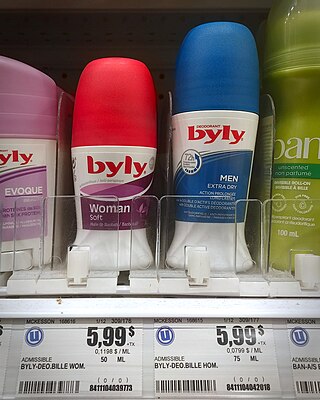
Price discrimination is a microeconomic pricing strategy where identical or largely similar goods or services are sold at different prices by the same provider in different market segments. Price discrimination is distinguished from product differentiation by the more substantial difference in production cost for the differently priced products involved in the latter strategy. Price differentiation essentially relies on the variation in the customers' willingness to pay and in the elasticity of their demand. For price discrimination to succeed, a firm must have market power, such as a dominant market share, product uniqueness, sole pricing power, etc. All prices under price discrimination are higher than the equilibrium price in a perfectly competitive market. However, some prices under price discrimination may be lower than the price charged by a single-price monopolist. Price discrimination is utilised by the monopolist to recapture some deadweight loss. This Pricing strategy enables firms to capture additional consumer surplus and maximize their profits while benefiting some consumers at lower prices. Price discrimination can take many forms and is prevalent in many industries, from education and telecommunications to healthcare.

AARP, formerly the American Association of Retired Persons, is an interest group in the United States focusing on issues affecting those over the age of fifty. The organization, which is headquartered in Washington, D.C., said it had more than 38 million members as of 2018. The magazine and bulletin it sends to its members are the two largest-circulation publications in the United States.

Price gouging is the practice of increasing the prices of goods, services, or commodities to a level much higher than is considered reasonable or fair. Usually, this event occurs after a demand or supply shock. This commonly applies to price increases of basic necessities after natural disasters. The term can also be used to refer to profits obtained by practices inconsistent with a competitive free market, or to windfall profits. In some jurisdictions of the United States during civil emergencies, price gouging is a specific crime. Price gouging is considered by some to be exploitative and unethical and by others to be a simple result of supply and demand.
Predatory lending refers to unethical practices conducted by lending organizations during a loan origination process that are unfair, deceptive, or fraudulent. While there are no internationally agreed legal definitions for predatory lending, a 2006 audit report from the office of inspector general of the US Federal Deposit Insurance Corporation (FDIC) broadly defines predatory lending as "imposing unfair and abusive loan terms on borrowers", though "unfair" and "abusive" were not specifically defined. Though there are laws against some of the specific practices commonly identified as predatory, various federal agencies use the phrase as a catch-all term for many specific illegal activities in the loan industry. Predatory lending should not be confused with predatory mortgage servicing which is mortgage practices described by critics as unfair, deceptive, or fraudulent practices during the loan or mortgage servicing process, post loan origination.
Equal pay for equal work is the concept of labour rights that individuals in the same workplace be given equal pay. It is most commonly used in the context of sexual discrimination, in relation to the gender pay gap. Equal pay relates to the full range of payments and benefits, including basic pay, non-salary payments, bonuses and allowances. Some countries have moved faster than others in addressing equal pay.
Employment discrimination is a form of illegal discrimination in the workplace based on legally protected characteristics. In the U.S., federal anti-discrimination law prohibits discrimination by employers against employees based on age, race, gender, sex, religion, national origin, and physical or mental disability. State and local laws often protect additional characteristics such as marital status, veteran status and caregiver/familial status. Earnings differentials or occupational differentiation—where differences in pay come from differences in qualifications or responsibilities—should not be confused with employment discrimination. Discrimination can be intended and involve disparate treatment of a group or be unintended, yet create disparate impact for a group.
Health care prices in the United States of America describe market and non-market factors that determine pricing, along with possible causes as to why prices are higher than in other countries.
A ladies' night is a promotional event, often at a bar or nightclub, where female patrons pay less than male patrons for the cover charge or drinks. In the United States, state courts in California, Maryland, Pennsylvania and Wisconsin have ruled that ladies' night discounts are unlawful gender-based price discrimination under state or local statutes. However, courts in Illinois, Minnesota, and Washington have rejected a variety of challenges to such discounts.

The Consumer Federation of California (CFC) was founded in 1960 as a nonprofit consumer advocacy organization. CFC campaigns for state and federal laws and appears at the California state legislature in support of consumer-focused regulations. The Consumer Federation of California is led by Executive Director Richard Holober and President Lucinda Sikes.
Economic discrimination is discrimination based on economic factors. These factors can include job availability, wages, the prices and/or availability of goods and services, and the amount of capital investment funding available to minorities for business. This can include discrimination against workers, consumers, and minority-owned businesses.

The Equal Treatment in Goods and Services Directive 2004 of 13 December 2004 is a directive which prohibits both direct and indirect sexual discrimination in the provision of goods and services in the European Union.
Housing discrimination refers to patterns of discrimination that affect a person's ability to rent or buy housing. This disparate treatment of a person on the housing market can be based on group characteristics or on the place where a person lives.
In the United States, health insurance marketplaces, also called health exchanges, are organizations in each state through which people can purchase health insurance. People can purchase health insurance that complies with the Patient Protection and Affordable Care Act at ACA health exchanges, where they can choose from a range of government-regulated and standardized health care plans offered by the insurers participating in the exchange.
Healthcare in the United States is largely provided by private sector healthcare facilities, and paid for by a combination of public programs, private insurance, and out-of-pocket payments. The U.S. is the only developed country without a system of universal healthcare, and a significant proportion of its population lacks health insurance.
Structural inequality occurs when the fabric of organizations, institutions, governments or social networks contains an embedded cultural, linguistic, economic, religious/belief, physical or identity based bias which provides advantages for some members and marginalizes or produces disadvantages for other members. This can involve, personal agency, freedom of expression, property rights, freedom of association, religious freedom,social status, or unequal access to health care, housing, education, physical, cultural, social, religious or political belief, financial resources or other social opportunities. Structural inequality is believed to be an embedded part of all known cultural groups. The global history of slavery, serfdom, indentured servitude and other forms of coerced cultural or government mandated labour or economic exploitation that marginalizes individuals and the subsequent suppression of human rights are key factors defining structural inequality. In particular the history of oppression of the Jewish people, as victims of historic and ongoing antisemitism that dates back to their slavery under the Pharaohs offer an example of the historic nature and wide variance of structural inequality.

James Albert Markham is an American hair stylist and serial entrepreneur, who has founded four hair care companies– Markham Products, ABBA Pure and Natural, PureOlogy Serious Colour Care, and, most recently, ColorProof Color Care Authority. He was also celebrity stylist Jay Sebring's protege and successor of Sebring International after Sebring was murdered by the Manson Family. Markham is known for advancing the Sebring cutting technique and introduced a generation of men to a new way of cutting and caring for their hair in the early 1970s, which emphasizes cutting hair in the direction it grows, daily washing and conditioning, and blow-drying. By 1973 Markham had improved upon the concept and took it nationwide over the next decade, coining the technique The Markham Method. Under his men's hair care line, Markham Products, he personally trained and certified thousands of barbers and stylists as Markham Style Innovators. The stylist's client list included many notable celebrities including Paul Newman, Steve McQueen, Frank Sinatra, Johnny Carson, Peter Lawford, Wolfman Jack, among many others. He also taught film producer and celebrity hairstylist Jon Peters the Sebring method.

Tampon tax is a popular term used to call attention to tampons, and other feminine hygiene products, being subject to value-added tax (VAT) or sales tax, unlike the tax exemption status granted to other products considered basic necessities. Proponents of tax exemption argue that tampons, sanitary napkins, menstrual cups and comparable products constitute basic, unavoidable necessities for women, and any additional taxes constitute a pink tax.

Arnold Schwarzenegger was an early opponent of same-sex marriage in the United States, including during his Governorship of California. As an elected official he opposed legal recognition of same-sex marriage but otherwise he supported LGBT rights legislation, including civil unions.

The pink tax refers to the tendency for products marketed specifically toward women to be more expensive than those marketed toward men. This phenomenon is often attributed to gender-based price discrimination, however research shows that the primary cause is women sorting into goods with higher marginal costs. The name stems from the observation that many of the affected products are pink.
In the United States, discrimination based on hair texture is a form of social injustice that has been predominantly experienced by African Americans and predates the founding of the country.








